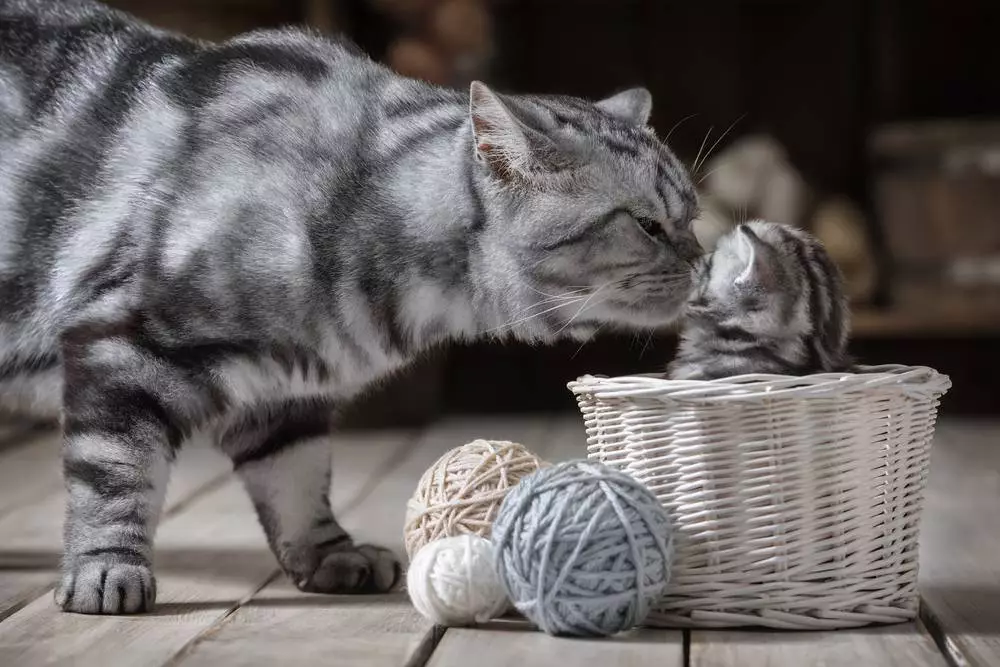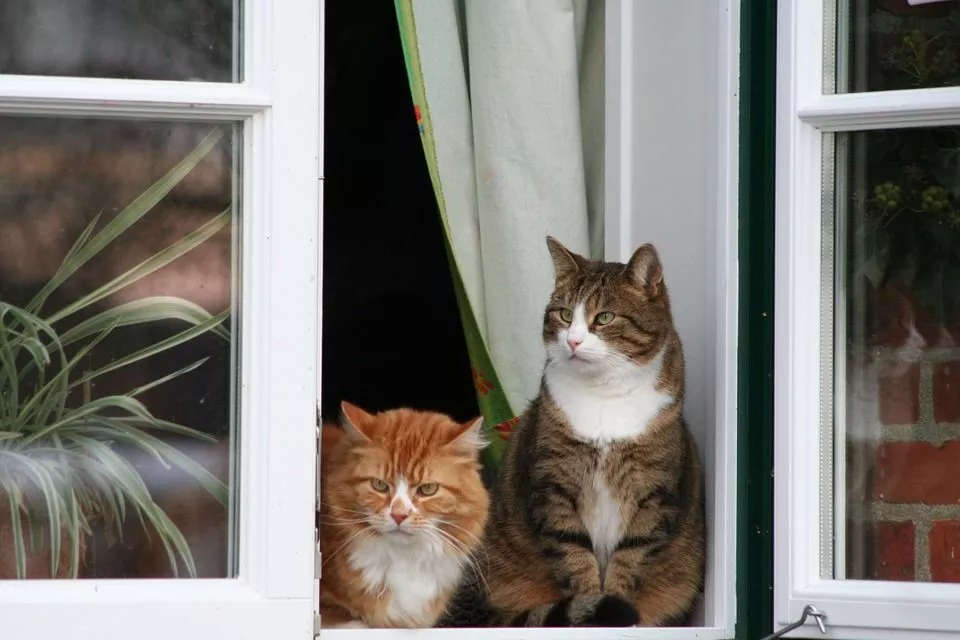Many households have more than one cat, and this is completely natural and normal.
Cats need the company of members of their species because in that way they will have physical activity, social interaction and mental stimulation that they cannot get from humans. As you can see for yourself, there are plenty of reasons to have more than one cat!
Of course, for the sake of peace in the house, it is important that the existing cat, or if there’s more of them, get to know the new cat each other with as little stress as possible.
The goal is to avoid any conflict, but cats can be very territorial and hence the challenge.
Do not despair, with patience and a lot of love, even the biggest cats will learn to accept new friends, and often become inseparable friends, and in this article we will show you a step by step process how to introduce your new cat to your old cat, and make them friends!
Preparing For The Introduction – Things To Do
First of, it is a good idea to take the kitten for an examination to determine his health. Conduct regular vaccinations of your cat, and depending on the age of the kitten, make sure that he is also vaccinated.
Ideally, in order for a kitten to eat kitten food, place his pots in another room or as far away from the pots of an older cat as possible.
Monitor feeding to prevent any aggressiveness and repulsion in a timely manner. You can continue to feed your kitten in a separate original room for a while.
Two or more cats in a household usually share a sandbox, but many adult cats aren’t exactly thrilled to share with a kitten, at least until the moment they’ll be accepted. Securing two sandboxes prevents an older cat from defecating in unacceptable places.
As for the kitten, you will need to insulate her. Choose a room in neutral territory and not where your cat sleeps or stays the most.
This will give you time to convince the cat that her status is not endangered, but you will also protect the new kitten from possible aggression.
Equip the kitten room with a cot, scratcher, urinal, food and water containers and toys. Place the kitten in the room and allow him to explore the room while you are with him. Then, leave him alone for a while to make him at home and feel comfortable in the new environment.
At first, the kitten might be hiding so try to get him to feel safer. But don’t rush because it could become less attached to you over time.

First Contact Between The Resident Cat And Your New Kitten
The first face-to-face contact should be short and pleasant.
For the first time, it is best for the two cats to meet it without touching, and always under your supervision. Owners usually use a mosquito net partition or a door frame over which a type of net is placed for this purpose.
Depending on the layout and furniture in your home, feel free to improvise a transparent partition that will allow cats to see and sniff, but prevent them from getting into unwanted chases or conflicts.
Cats at this stage usually quickly get used to looking at each other, without danger or desire to fight. At this stage, repeat the feeding of both cats in close proximity to each other in order to repeat the positive experience in both.
You can also give treats to one cat when it does not show signs of hostility in the presence of another, but shows the desired calm behavior.
Repeat these procedures as often as possible, several times a day. When the cats on opposite sides of the barrier get used to each other without any hint of a negative reaction, you can slowly move on to the next step.
Gradually alow the two cats to get closer to each other or stay as close to each other as they want. Repeat brief encounters as often as necessary until you feel comfortable in the same room, of course, under supervision. Don’t expect instant friendship, this still takes time.
In the beginning, even the calmest cat will show concern when a new kitten appears.
As the animals get to know each other by smell, your cat will therefore probably spend a lot of time sniffing the door of the room where you have placed the new kitten. The kitten will do this on the other side of the door.
Don’t leave cats alone together at the very beginning, even if the face-to-face acquaintance went perfectly well. A new cat should stay in your room when no one is home, to avoid quarrels and harassment while you are away.
Just like humans, siblings, cats sometimes get along – they eat from the same bowl, share a bed and a toilet bowl, while on other occasions they can live together but want their own food bowls, sleeping places and toilets.
All pets have a fear of change, and some cats find it harder to get used to changing circumstances than others. It is a good idea to try natural preparations to calm their nerves.
Be Patient
After a day or two, the cat’s reaction to the new kitten will be seen. If she is excited to meet a new kitten she will behave generally interested, curious, prestige and be in a friendly mood.
But if she seems upset and produces hissing sounds it’s best to wait a few more days with the introduction, when you’ll try to make contact again. Don’t rush.
When the cat seems ready, meet them in such a way that you open the door just enough so that they can be seen and smelled. Be close to them.
Depending on the reaction, gradually open the door more and more for a short time until you get used to the mutual contacts without getting upset. This can sometimes take several days but is almost always successful.
When you bring a new kitten home, your cat will need a lot of extra attention because you need to know that you still love her and that the newly arrived kitten is not a threat to her position in the household.
Also, keep in mind that cats are possessive of food and food and water containers.
Personality Of Your Cat
Regardless of the personality of your cat, even if she seems very peaceful and friendly, there is no guarantee that she will accept the new kitten with joy and tolerance.
However, many peaceful kittens accept any newcomer pet immediately and without any problems. This is especially true for neutered or castrated cats.
According to research, there is no significant difference in the aggressiveness of male or female kittens. Some cats adapt to changing circumstances faster and better than others.

How To Get Your Cats To Like Each Other
You’re probably excited about an extra, furry family member, but your current cat may not share your enthusiasm. A new cat often causes jealousy, competition and quarrels. It may not be as lovely an experience as you expected. To avoid negative tensions between two cats and unnecessary stress, follow these tips and suggestions on how to get to know them.
1. Slow Interaction
One way to introduce a new cat or kitten to the current one is through slow interaction. Place the new kitten in a separate room and close the door. Give both cats access to a place to go to the bathroom, food and water, and a place where they can hide, drink cardboard boxes with a blanket or towel in it.
Once the new kitten has had enough time to get used to the new space, you can start exchanging scents, replacing the items from the rooms where the cats are, and which they often use, such as blankets.
You can place such items next to the food container. This will give both of them a chance to get used to eating in the presence of the smell of the other cat.
2. Using Cloths And Napkins
If there are no hissing or aggressive sounds due to the presence of objects, replace their food bowls during the next meal. If there is a hiss and other sounds on the object, move it away from the original place to a place they can access when they wish.
Use a cloth or napkins for pets in the areas of the cat’s cheeks, because this is where they produce “friendly” hormones. Then take a cloth or napkin and stroke the other cat in the same way. This approach will help them get used to the scents in a friendly way.
You can make them even more friendly by giving them a treat every time you exchange their scents.
3. Bring Their Food Bowls Closer
The next step is to bring the food bowls closer to the door that separates them on both sides, but not too close.
If you do this, your cats will will feel more comfortable while eating, and will not feel threatened by each other, and will know that another cat is present at the same time.
Gradually bring the bowls closer to the door, to feel the presence of each other more, but still keep them apart. In addition, try to change their place of residence.
Pro tip: You can additionally give them treats when they nail their snouts to the door, smelling and listening to their new friends on the other side. In this way, the cats will connect the prize and delicious snacks with the presence of a new, unknown cat, and that will help in the process of getting to know each other.
4. Territory
Take your current cat to another room and let the new one explore the rest of the space. This will give them a chance to get used to staying in a space that also contains the smell of another cat, as well as the environment that surrounds them.
The next stage is to open the door enough that they can be seen and smelled, but they can’t get past each other. This allows them to approach each other voluntarily, and if either of them feels threatened from the other side, that they can withdraw.
When you feel that there is no aggression between the cats after all the steps have been taken, let them get to know each other completely.
If you notice aggressive signs, make some loud noise or throw something on the floor like keys to distract them and stop a potential quarrel. If that doesn’t work either, separate them again and further slow down the acquaintance.

How Long Does It Take For A Cat To Get Used To A New Cat?
Sometimes it takes a year or longer for an older cat and kitten to feel comfortable next to each other.
Cats make new acquaintances slowly, and gaining trust can take weeks, if not months. During this period, the newcomer will always be close to the group, but never too close.
In most cases, especially if both cats display aggressive or fearful behavior in the beginning of their relationship, it happens that they never become real friends but simply learn to tolerate each other.
The length and complications mostly depend on the age of the cats they meet. The older the host cat, the harder it will be to accept newcomers. If you bring a young kitten into your home, the dating period will most likely be very short. If problems arise, accept them and be patient.
How Do I Get My Cat To Stop Attacking My Other Cat?
Cats know how to defend their territory by showing aggression towards another cat.
The new cat should be placed in a separate room where they will have their own toilet, bed and water containers. Cats will be able to smell through the neck, but will not be able to reach each other.
After a few days, swap their positions by letting the old cat into the room from the new one and vice versa to explore each other’s scents. You can expect a little blowing.
After that, in the same room, but with disabled contact (transporter or leash), let them eat to connect the comfort of feeding with the new animal.
The last step is to let them free in the space and feed them, if in the previous step they ate relaxed. The whole process can take weeks to months. In the end the old cat will generally always accept or at the very least tolerate the newcomer.

How To Stop The Fight Between Your Residents Cat And Your New Cat
The best way to stop the fight between your residents cat and your new cat is to throw a toy that cats normally play with, next to them, in their immediate vicinity. This will distract them and reduce tension.
You can also throw a pillow next to them and the sound of hitting the floor should separate them from the combat clinch. If that doesn’t help either, spray them with a little water. This reliable recipe should be enough to stop cats from fighting.
If physical fights between cats happen often, know that there is some deeper cause that leads to it.
Cats do not start fighting at once, but need time in which internal dissatisfaction escalates into physical conflict.
For example, if you suddenly bring a new cat into the house, the old cat will feel threatened if there is not enough time to adjust.
Also, if other cats often come to your yard while your cat is watching it from the window, she will pounce on another cat in the household because of frustration that she can’t drive away outside cats.
Various health problems can lead to increased aggression in cats, so this should be taken into account as well. If cats start fighting at meal time, it could be a sign that one of them is not getting enough food and is therefore frustrated. Make sure you’re giving enough time to both of your cats.
Cats also fight when there is a change in their hierarchy, that is, when they cannot show their status, so it is good to put various shelves and ladders to help them show their position in society more clearly.
The reasons can be numerous, but try to identify and eliminate them because ignoring aggressive behavior is not the solution.
Why Does My Old Cat Hate My New Cat?
Many owners of two cats are likely to recognize their pets in examples of cats that are intolerable, but is the hatred we see real?
To better understand what is going on, we need to look at how cats relate to each other in nature.
Cats live either as solitary animals or as part of a group with well-known members. Everyone outside that group is considered an intruder and, accordingly, dangerous. This is not overly strange given that it is well known that adult males often kill cubs.
Cats live by the motto that the best defense is a strong attack, so strangers often have to flee if they get too close to a group of cats.
Keep in mind that small signs of aggression, such as hissing or attitude, without attack are just signs of setting up a hierarchy and order between the two so they can live together. If they continue or move into physical contact, you will need to separate them and move on from the steps where getting to know them was still enjoyable.
Importance Of Safe Territory
Your old cat will generally find it difficult to accept a new cat into your home, but it is not about hatred, but about fear for you and yourself. This is completely normal.
Once the old cat realizes that the new cat is not dangerous, the situation between them should stabilize.
It is also important how you meet the two cats. At first, it is wise to keep them in separate rooms. After a day or two, swap their space to get them used to the smell of a foreign cat. Meet them after a few days. Both cats must have their own food and toilet bowls.
In some cases, nothing will help – no gradual acquaintance, no rewards for good behavior. You have to accept the possibility that, as in the case of humans, some cats are simply disliked by each other. Lonely cats also don’t like company, so that too can be a reason for disagreement.
Cats that are adopted prematurely may not have learned how to behave, so this can create significant problems compared to other cats.
The realistic expectation of owners of multiple cats is that pets will be able to be in the same room without being aggressive towards each other. If cats are chronically attacked, it is wise to seek the help of someone who is expert in cat behavior.

Things To Watch Out For When Introducing A New Cat To Your Household
After having introduced your new cat to your old cat, it will take some time before they both get adjusted to their new life together.
This may come with or without struggles, it may be challenging or it may be a very easy transition. Nevertheless, it is important to pay attention to certain things even after the cats are introduced to each other, and especially in the first few weeks and months together.
1. Do Not Leave Your Cats In The Same Room Together
When a new cat or kitten comes to your family, it is best to prepare a separate room that will have everything they need: a quiet place to sleep, food and water containers, toys, a toilet. Your existing cat should not have free access to this room at first!
Separation has several obvious advantages. It allows your first cat to get used to the fact that new animals now live on its territory, without their direct contact. In addition, the new cat should also have the opportunity to get used to the smells and sounds of the new space, without fear of retaliation from the host cat.
2. Health Related Risks
It is useful and recommended for each new pet to spend some time in some kind of quarantine, even if it has already been vaccinated and healthy, purely as a precaution to determine that the animal is really healthy. This way you will protect your existing cats from any diseases they might get from the newcomer.
In the first phase of physical separation, all your cats should be able to sniff and hear each other. Although they will, out of curiosity, stay near the door that separates them, you can feed them both on opposite sides of the door – to get used to new smells. Feeding close to each other will also create a lasting positive experience related to the smell of a new cat.
3. Odor Exchange
The next step after the first week may be to exchange things that your cats sleep on. It is enough that the cat slept for a couple of days on a certain piece of cloth to clearly leave its scent on it.
Swap those beds with each other and let them continue to sniff and explore on their own, to make sure the smell of a new friend is not in danger.
Most cats go through this phase without negative reactions, but if there is resentment or stress, be patient and extend the duration of this step for another week.
4. Leaving The Household
Make sure to remember that even if you, as the owner, leave the house, still do not leave the cats together unattended!
Lastly, if everything is going according to plan over time and cats are more and more used to each other, you can let both cats move freely around the apartment whenever you are at home.
The most important thing in this process is to be patient and to do everything gradually and without haste. The results are positive in almost all of the cases.
And it will be only a matter of time before your cats become friends who huddle together in a warm corner when winter comes!
Was my article useful to you? Do you have any questions or thoughts to share? Let me know in the comments below!


Leave a Comment